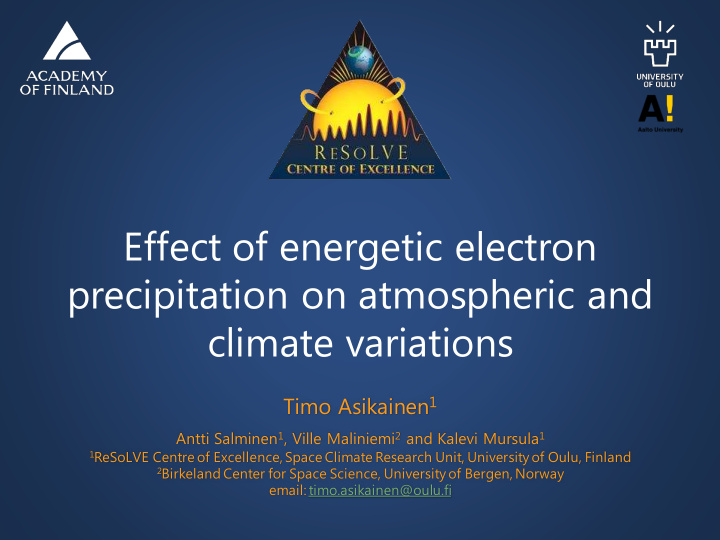



Effect of energetic electron precipitation on atmospheric and climate variations Timo Asikainen 1 Antti Salminen 1 , Ville Maliniemi 2 and Kalevi Mursula 1 1 ReSoLVE Centre of Excellence, Space Climate Research Unit, University of Oulu, Finland 2 Birkeland Center for Space Science, University of Bergen, Norway email: timo.asikainen@oulu.fi
Northern Annular Mode (NAM)/ North Atlantic Oscillation (NAO) Main circulation pattern in the Northern Hemisphere (North Atlantic) winter • NAM and NAO closely related • • NAO Phase significantly affects wintertime weather in Eurasia and North-American continent Negative NAO Positive NAO Low pressure High pressure Wet, warm Dry, cold dry wet Low pressure High pressure
Polar vortex and QBO During winter polar • stratosphere cools • ➔ Low pressure ➔ Westerly wind around it • • ➔ Polar vortex • In the equatorial stratosphere the wind direction alternates roughly in 28 month period • ➔ QBO (Quasi-Biennial Oscillation) QBO affects atmosphere in • many ways, e.g., wave propagation, meridional circulation etc.
Effect of EEP on winter time surface temperatures We compared NASA/GISS wintertime (Dec-Feb) surface • temperatures in 1980-2010 to POES electron fluxes and NAO index (Maliniemi et al., 2013) • NAO correlates with Energetic Electron Precipitation (EEP) • EEP produces a NAO-type surface temperature variation • Similar results have been obtained also by others based on observations and climate models Temperature variation Temperature variation Relation between NAO related to EEP variation related to NAO index index and EEP flux cc=0.44 p=0.015
Effect of EEP on winter time surface temperatures • The EEP-NAO (temperature) connection is mostly visible only when statospheric QBO (30 hPa) is easterly
Solar cycle occurrence of particles and solar wind speed • EEP maximises in the declining phase of the solar cycle
Solar wind driver of EEP • High-speed solar wind streams from solar coronal holes is the dominant driver of EEP (Energetic Electron Precipitation) (Asikainen & Ruopsa, 2016) • EEP maximises in the declining solar cycle phase
Surface temperature in different solar cycle phases (1880-2013) • ➔ We computed relative temperature distributions in each solar cycle phase separately in 1880-2013 (Maliniemi et al., 2014) • Only the declining phase is statistically significant and shows positive NAO type temperature pattern 1.0 ˚C p=0.04 -1.7 ˚C, p<0.01
Preference for positive NAO in declining phase • NAO is systematically positive in declining phase of all (except 1) solar cycles!
Correlation between aa index and NAO/NAM • Correlation between NAM index of surface temperature and aa index in different winter months (2 month averages) Maliniemi et al. (2016) • • ➔ Correlation stronger in QBO-E and persistent throught last 100 years
Response to EEP throughout the atmosphere • ERA-Interim data vs. POES EEP fluxes (Salminen et al., 2019) • Time period 1980-2016 • Increase in EEP is related to O3 loss Temperature response Zonal wind enhancement
Zonal wind response in two QBO phases • EEP responses QBO-E especially in late winter Feb-Mar are much stronger when QBO (30 hPa) is easterly QBO-W
Possible cause for QBO modulation Going through all QBO lags shows that • largest differences in EEP response occur with a lag of about 6 months. Same lag maximises the difference in • ozone transported to the polar region between QBO phases ➔ EEP response is strongest when • meridional circulation is strongest
Conclusions • EEP effect on tropospheric climate variations has been shown using – Different re-analysis datasets covering different periods of time – Different measures for EEP (direct satellite fluxes, geomagnetic activity, solar cycle phase) • EEP causes indirect ozone loss ➔ lower stratosphere cooling and upper stratosphere warming ➔ polar vortex enhancement ➔ Positive NAM/NAO on ground • All these responses are stronger in QBO-E and very weak in QBO-W • Cause for QBO modulation is related to changes in meridional circulation
The End
Recommend
More recommend